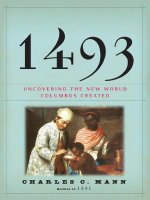T j stiles the first tycoon the epic lif ilt (v5 0)
Bạn đang xem bản rút gọn của tài liệu. Xem và tải ngay bản đầy đủ của tài liệu tại đây (8.24 MB, 675 trang )
ALSO BY T. J. STILES
Jesse James:
Last Rebel of the Civil War
To Jessica and Dillon,
for giving me the future
To understand just one life, you have to swallow the world.
—SALMAN RUSHDIE,
Midnight's Children
Contents
List of Illustrations
List of Maps
Part One
CAPTAIN 1794–1847
1 The Islander
2 The Duelist
3 A Tricky God
4 Nemesis
5 Sole Control
6 Man of Honor
Part Two
COMMODORE 1848–1860
7 Prometheus
8 Star of the West
9 North Star
10 Ariel
11 Vanderbilt
12 Champion
Part Three
KING 1861–1877
13 War
14 The Origins of Empire
15 The Power to Punish
16 Among Friends
17 Consolidations
18 Dynasty
Epilogue
Acknowledgments
Bibliographical Essay
Notes
Primary Source Bibliography
Illustrations
INSERT FOLLOWING PAGE 106
Phebe Vanderbilt
The Quarantine, Staten Island
Sophia Johnson Vanderbilt
Battery Park
The Fly Market
Tontine Coffee House
Thomas Gibbons
Bellona Hall
Destruction of the Lexington
A view of New York
Cornelius Vanderbilt
Daniel Drew
George Law
William H. Vanderbilt's farmhouse
Cornelius Vanderbilt
San Francisco, 1848
INSERT FOLLOWING PAGE 298
Abandoned ships, San Francisco, 1849
Greytown Harbor
San Juan River
San Carlos
Virgin Bay
San Juan del Sur
San Francisco, 1851
The Narrows
Steamship Row
Cornelius K. Garrison
William Walker
Execution of Ponciano Corral
Hipp's Point
Merchants' Exchange
The steamship Vanderbilt
George W. Vanderbilt
William H. Vanderbilt
The steamship Champion
The Merrimack vs. the Monitor
INSERT FOLLOWING PAGE 531
USS Vanderbilt
Cornelius Vanderbilt
Sighting the Alabama
Capture of the Ariel
Harlem Railroad Station, Twenty-sixth Street and Fourth Avenue
Commodore Vanderbilt locomotive
Hudson River Railroad Station, Chambers Street
Horace F. Clark
Augustus Schell
The Albany Bridge
Henry Keep
Erastus Corning
Jay Gould
James Fisk Jr.
Thomas A. Scott
St. John's Park Freight Depot
The Vanderbilt statue
Stock watering (cartoon)
Racing Fisk (cartoon)
Grand Central Depot under construction
Grand Central Depot
Grand Central Depot car house, exterior view
Grand Central Depot car house, interior view
Fast train to Chicago
New York Central & Hudson River Railroad
Fast trotters on Harlem Lane
Mountain Boy
Congress Hall veranda, Saratoga Springs
Cornelius Vanderbilt
Tennessee Claflin
Victoria Woodhull
Horace Greeley
Frank Crawford Vanderbilt
Ethelinda Vanderbilt Allen
Sophia Vanderbilt Torrance
Mary Vanderbilt La Bau
Going to the Opera
The run on the Union Trust
Vanderbilt at rest
Death of Cornelius Vanderbilt
Funeral of Cornelius Vanderbilt
Burial of Cornelius Vanderbilt
Dr. Jared Linsly at the will trial
New York, 1880
Maps
New York Bay
Southern New England
New York
Gold Rush Steamship Lines
Nicaragua
The Trunk Lines
Chapter One
THE ISLANDER
T
hey came to learn his secrets. Well before the appointed hour of two o'clock in the
afternoon on November 12, 1877, hundreds of spectators pushed into a courtroom
in lower Manhattan. They included friends and relatives of the contestants, of
course, as well as leading lawyers who wished to observe the forensic skills of the
famous attorneys who would try the case. But most of the teeming mass of men and
women—many fashionably dressed, crowding in until they were packed against the
back wall—wanted to hear the details of the life of the richest man the United States
had ever seen. The trial over the will of Cornelius Vanderbilt, the famous, notorious
Commodore, was about to begin.
Shortly before the hour, the crowd parted to allow in William H. Vanderbilt, the
Commodore's eldest son, and his lawyers, led by Henry L. Clinton. William, “glancing
carelessly and indi erently around the room, removed his overcoat and comfortably
settled himself in his chair,” the New York Times reported; meanwhile his lawyers shook
hands with the opposing team, led by Scott Lord, who represented William's sister Mary
Vanderbilt La Bau. At exactly two o'clock, the judge—called the “Surrogate” in this
Surrogate Court—strode briskly in from his chambers through a side door, stepped up to
the dais, and took his seat. “Are you ready, gentlemen?” he asked. Lord and Clinton
each declared that they were, and the Surrogate ordered, “Proceed, gentlemen.”1
Everyone who listened as Lord stood to make his opening argument knew just how
great the stakes were. “THE HOUSE OF VANDERBILT,” the Times headlined its story the next
morning. “A RAILROAD PRINCE'S FORTUNE. THE HEIRS CONTESTING THE WILL.… A BATTLE OVER $100,000,000.” The
only item in all that screaming type that would have surprised readers was the Times's
demotion of Vanderbilt to “prince,” since the press usually dubbed him the railroad king.
His fortune towered over the American economy to a degree di cult to imagine, even
at the time. If he had been able to sell all his assets at full market value at the moment
of his death, in January of that year, he would have taken one out of every twenty
dollars in circulation, including cash and demand deposits.2
Most of those in that courtroom had lived their entire lives in Vanderbilt's shadow. By
the time he had turned fty he had dominated railroad and steamboat transportation
between New York and New England (thus earning the nickname “Commodore”). In the
1850s, he had launched a transatlantic steamship line and pioneered a transit route to
California across Nicaragua. In the 1860s, he had systematically seized control of the
railroads that connected Manhattan with the rest of the world, building the mighty New
York Central Railroad system between New York and Chicago. Probably every person in
that chamber had passed through Grand Central, the depot on Forty-second Street that
Vanderbilt had constructed; had seen the enormous St. John's Park freight terminal that
he had built, featuring a huge bronze statue of himself; had crossed the bridges over the
tracks that he had sunk along Fourth Avenue (a step that would allow it to later blossom
into Park Avenue); or had taken one of the ferries, steamboats, or steamships that he
had controlled over the course of his lifetime. He had stamped the city with his mark—a
mark that would last well into the twenty- rst century—and so had stamped the
country. Virtually every American had paid tribute to his treasury.
More fascinating than the fortune was the man behind it. Lord began his attack by
admitting “that it seemed hazardous to say that a man who accumulated $100,000,000
and was famous for his strength of will had not the power to dispose of his fortune.” His
strength of will was famous indeed. Vanderbilt had rst amassed wealth as a competitor
in the steamboat business, cutting fares against established lines until he forced his
rivals to pay him to go away. The practice led the New York Times, a quarter of a
century before his death, to introduce a new metaphor into the American vernacular by
comparing him to the medieval robber barons who took a toll from all passing tra c on
the Rhine. His adventure in Nicaragua had been, in part, a matter of personal
buccaneering, as he explored the passage through the rain forest, piloted a riverboat
through the rapids of the San Juan River, and decisively intervened in a war against an
international criminal who had seized control of the country. His early life was lled
with st ghts, high-speed steamboat duels, and engine explosions; his latter days were
marked by daredevil harness races and high-stakes confrontations.
It was this personal drama that moved that crowd of spectators into the courtroom
eleven months after his death, but more thoughtful observers mulled over his larger
meaning. Vanderbilt was an empire builder, the rst great corporate tycoon in
American history. Even before the United States became a truly industrial country, he
learned to use the tools of corporate capitalism to amass wealth and power on a scale
previously unknown, creating enterprises of unprecedented size. “He has introduced
Caesarism into corporate life,” wrote Charles Francis Adams Jr. “Vanderbilt is but the
precursor of a class of men who will wield within the state a power created by it, but
too great for its control. He is the founder of a dynasty.”3
Adams did not mean a family dynasty, but a line of corporate chiefs who would
overshadow democratic government itself. Rockefeller, Carnegie, Gould, Morgan—all
were just beginning their careers when Vanderbilt was at his height. They respected and
followed his example, though they would be hard-pressed to match it. Few laws had
constrained him; few governments had exceeded his influence. In the 1850s, his personal
role in Central America had been more important than that of the White House or the
State Department. In 1867, he had stopped all trains into New York City from the west
to bring the New York Central Railroad to its knees. In 1869, he personally had abated a
panic on Wall Street that threatened to ring in a depression.
His admirers saw him as the ultimate meritocrat, the nest example of the common
man rising through hard work and ability To them, he symbolized America's
opportunities. His critics called him grasping and ruthless, an unelected king who never
pretended to rule for his people. Still worse, they saw him as the apex of a vulgar new
culture that had cast o the republican purity of the Revolution for the golden calf of
wealth. “You seem to be the idol of… a crawling swarm of small souls,” Mark Twain
wrote in an open letter to Vanderbilt, “who… sing of your unimportant private habits
and sayings and doings, as if your millions gave them dignity”4
Perhaps there were those who understood that Vanderbilt's true signi cance was more
complex, even contradictory. How could it not be? His life spanned a period of
breathtaking changes, from the days of George Washington to those of John D.
Rockefeller (with whom he made deals). He began his career in a rural, agricultural,
essentially colonial society in which the term “businessman” was unknown; he ended it
in a corporate, industrial economy5 Neither the admirers nor the critics of his later years
had witnessed his role during the tumultuous era of the early republic and the
antebellum period. They could not see that Vanderbilt had spent most of his career as a
radical force. From his beginnings as a teenage boatman before the War of 1812, he had
led the rise of competition as a virtue in American culture. He had disrupted the
remnants of the eighteenth-century patricians, shaken the conservative merchant elite,
and destroyed monopolies at every step. His infuriated opponents had not shared his
enthusiasm for competition; rather, the wealthy establishment in that young and limited
economy saw his attacks as destructive. In 1859, one had written that he “has always
proved himself the enemy of every American maritime enterprise,” and the New York
Times condemned Vanderbilt for pursuing “competition for competition's sake.”6 Those
on the other end of the spectrum had celebrated the way he had expanded
transportation, slashed fares, and punished opponents who relied on government
monopolies or subsidies. To Jacksonian Democrats, who championed laissez-faire as an
egalitarian creed, he had epitomized the entrepreneur as champion of the people, the
businessman as revolutionary.
But the career that started early ended late, and the revolutionary completed his days
as emperor. As he had expanded his railroad domain from the benighted New York &
Harlem—annexing the Hudson River, the New York Central, the Lake Shore & Michigan
Southern, and the Canada Southern—he had seemed not a radical but a monopolist. His
role in the Erie War of 1868, with its epic corruption of public o cials, had made him
seem not a champion but an enemy of civic virtue. He played a leading part in the
creation of a new entity, the giant corporation, that would dominate the American
economy in the decades after his death. The political landscape had changed as well.
With the rise of large railroads and the expansion of federal power during the Civil War,
radicals began to think of the government as a possible counterweight to corporate
might. Vanderbilt had remained as committed to laissez-faire as ever; as he told the
newspapers more than once, his guiding principle was “to mind my own business,” and
all he asked from government was to be left alone.7 He never acknowledged that, as
Charles F. Adams Jr. wrote, the massive corporations he commanded gave him power to
rival that of the state, and that he became the establishment against which populists
armed themselves with government regulation.
Probably no other individual made an equal impact over such an extended period on
America's economy and society. Over the course of his sixty-six-year career he stood on
the forefront of change, a modernizer from beginning to end. He vastly improved and
expanded the nation's transportation infrastructure, contributing to a transformation of
the very geography of the United States. He embraced new technologies and new forms
of business organization, and used them to compete so successfully that he forced his
rivals to follow his example or give up. Far ahead of many of his peers, he grasped one
of the great changes in American culture: the abstraction of economic reality, as the
connection faded between the tangible world and the new devices of business, such as
paper currency, corporations, and securities. With those devices he helped to create the
corporate economy that would de ne the United States into the twenty- rst century.
Even as he demonstrated the creative power of a market economy, he also exacerbated
problems that would never be fully solved: a huge disparity in wealth between rich and
poor; the concentration of great power in private hands; the fraud and self-serving
deception that thrives in an unregulated environment. One person cannot move the
national economy single-handedly—but no one else kept his hands on the lever for so
long or pushed so hard.
The spectators in that courtroom, then, could mark Vanderbilt down as complicated
indeed, even before the rst witness spoke. Yet what pulled them there was perhaps not
so much his national signi cance as his strange, powerful character, his mysterious
personal life. Public rumor depicted a home wracked by intrigue, spiritualist séances,
and Vanderbilt's controversial sponsorship of the feminist Victoria Woodhull and her
voluptuous sister, Tennie C. Cla in. What the public did not see was his emotional
complexity: his patient business diplomacy, his love for his rst and second wives (as
well as his sel shness with them), and his con icting feelings about his often di cult
children—especially Cornelius Jeremiah, who struggled with epilepsy and an addiction
to gambling. Contemporaries and posterity alike often would overlook the very human,
even sympathetic, side of the imperious Commodore, attracted instead to the most
salacious, scandalous, and overblown reports.
It was his nal act that brought everyone into that courtroom, an act that combined
the personal and the corporate. He had built something that he meant to last and
remain in the hands of his own bloodline—to found a dynasty in the most literal sense.
To that end, he had drafted a will that left 95 percent of his estate to his eldest son,
William. William's sister Mary meant to break that dynasty by breaking the will, to
force a distribution of the estate equally among the ten surviving children.
Would she succeed? Each side would ght to de ne Vanderbilt; each side would seek
out its own answer to the enigma of a man who left few letters and no diaries. Lord
began to speak, and the crowd bent forward to listen, straining to learn who the
Commodore really was.
. For Phebe Hand Vanderbilt, another child meant more of
the same. In May 1794, during the last month of her fourth pregnancy, her rst three
children, Mary, Jacob, and Charlotte, ran about their humble house. Knowing the
Vanderbilt tradition, she could expect many more to follow the unborn infant in her
womb. Continuity not change, de ned everything about her existence, an existence that
di ered little from that of her parents, grandparents, or great-grandparents. She sat in
wooden furniture hand-cut from hand-hewn lumber. She wore clothes hand-sewn from
hand-spun wool. She washed cups and plates that had been spun on a wheel, and bottles
blown by a craftsman's mouth. Looking out a window, she would see hand-built wagons
harnessed to teams of horses. Peering a little farther, she could watch the sloops and
ships that sailed by the shore just steps from her door. And at night she would light the
room with a mutton-fat candle or a whale-oil lamp.
Phebe lived in a close wooden world made by human hands, powered by winds and
horse and human strength, clustered at the water's edge. Most of the technology she
knew had been rst imagined thousands of years before. Even the newest inventions of
her time—the clock, the printing press, the instruments of navigation—dated back to the
early Renaissance. The “Brown Bess” muskets stored in U.S. arsenals and carried by
British redcoats had been designed in the 1690s, a full century before. Revolutions were
a matter for politics; the constructed world merely crept ahead.8
Phebe lived in Port Richmond, that most ancient kind of community—a farming
village, its air pungent with the smell of animal manure and open res, its unpaved
paths sticky with mud from the season's rains. It sat on the northern edge of Richmond
County better known as Staten Island, a sprawling, sparsely occupied landscape of not
quite four thousand souls who still governed their a airs with town meetings. The
islanders tilled the steep green hillsides, let pigs wander and forage for themselves, and
built their houses close to the soft, swampy shores that crumbled into the kills—the tidal
creeks that wrapped around the island's edges. Staten Island sat like a stopper in the
mouth of New York Harbor, separated from Long Island by the two-mile-long Narrows,
where the ocean decanted into the bay. West of Staten Island stretched the mainland of
New Jersey, and across the length of the harbor sat Manhattan, a long and narrow
island that extended between the deep East and Hudson (or North) rivers like a natural
pier of bedrock.
An island is de ned by its edges. Phebe looked across the water for her husband's
return whenever he was gone, until he sailed up in his boat and tied it fast. His name
was Cornelius. It was a solid Dutch name, as was Vanderbilt, and both were common
around New York Bay. The rst of his family had arrived in America in 1650, when Jan
Aertsen Van Der Bilt settled in the Dutch colony of New Netherlands. In 1715, long after
the English had conquered the province and renamed it New York, one of Jan's
descendants had crossed the water to sparsely populated Staten Island. That one move
A CHILD, IT IS SAID, CHANGES EVERYTHING
was change enough, it seems, for the family that dispersed and multiplied there. The
ensuing generations lived out their lives as farmers or tavern keepers, unmoved by the
climactic North American war with France in the 1750s, the outbreak of revolution two
decades later, the British occupation of their island, the triumph of independence, the
rati cation of the Constitution, and the swearing in of President George Washington in
Manhattan.
On May 27, 1794, Phebe gave birth to her fourth child. She underscored the sense of
continuity by naming him Cornelius, too, though they called the boy Cornele. She cooed
over him in English. Phebe had rst met her husband in Port Richmond, a heavily Dutch
village, where she had been working as a servant in the home of a minister, but she
herself came from an old English family in New Jersey.
In the town of New York this sort of intermarriage surprised no one. There the Dutch
had fallen to less than half the population as early as 1720; now they were less a
minority than an interbred strand among its 33,000 residents. As early as the rule of
Petrus Stuyvesant in 1647, the village then named New Amsterdam had grown into a
rather cosmopolitan place. Stuyvesant governed under the authority of the Dutch West
India Company, created to mobilize merchant capital to advance Dutch interests in the
New World. Under his administration, the little seaport came to re ect the commercial
orientation of the Netherlands, the most industrious nation of seventeenth-century
Europe. As in the mother country, the primacy of trade, foreign trade in particular, had
fostered a tolerance of strangers and disparate creeds (at a time when being a Quaker
was a hanging offense in Massachusetts), and that tradition persisted.9
On Staten Island, a slightly di erent legacy prevailed. Most of the original Dutch
settlers in New Netherlands, including Jan Aertsen Van Der Bilt, came to farm. They
spread out on either side of New York Bay and the Hudson River (known as the North
River well into the nineteenth century) from Staten Island to Albany. Theirs was an
inward-looking, rural society and Americans of British descent often viewed them with
distaste. “Nothing can exceed the state of indolence and ignorance in which these
Dutchmen are described to live,” wrote traveler William Strickland in the 1790s. “Many
of them are supposed to live and die without having been ve miles from their own
houses.” Outsiders generally considered the Dutch rude; one English-speaking Hudson
Valley resident, for example, complained about “what I call Dutch politeness.” At times
suspicion boiled over into blows.10
These great-great-grandchildren of the Netherlands carried on old customs for decade
after decade. As late as 1836, a diarist wrote, “It is di cult to turn the Dutch population
from their old established ways.” Women in high caps continued to serve “oely-coeks,”
sweetened balls of deep-fried dough; men often went about in traditional clothes,
including the broad-brimmed beaver hat. And they preferred to speak “Laeg-Duits,” or
“Low Dutch.” By 1790, this dialect had evolved into a tongue that was incomprehensible
to natives of the Netherlands, but it was heard all along the North River and New York
Harbor. In one telling measure, three-quarters of 1,232 runaway slaves in the region at
the beginning of the nineteenth century spoke Low Dutch.
Those slaves point to another difference between the Dutch and their English-speaking
neighbors. In 1799, the state of New York passed the Gradual Manumission Act, phasing
out slavery over twenty-eight years. Opposition to the law came largely from rural
Dutch areas. In 1790, only 11.3 percent of English families owned slaves, compared to
27.9 percent of the Dutch—and one out of every three families in northern Staten
Island. As international merchants, the Dutch had played a central part in introducing
slavery to North America; as New York-area farmers, they carried on the institution to
the last.11
Slavery, in addition to being an oppressive social system, was a commercial
institution, providing both labor and property. Its presence revealed another distinctive
feature of the rural Dutch: they farmed for pro t. In the seventeenth and eighteenth
centuries, this was a notable fact. Even into the 1800s, many English-speaking farmers
in New York and New England devoted much of their e ort to subsistence—though not
necessarily by choice—whereas Dutch farming “was market-oriented,” in the words of
one historian, “and derived its distinct regional characteristics from Dutch tradition.”
The rural Dutch, then, shared much of the commercial consciousness of their urban
brethren. They clattered their wagons into Albany, New Brunswick, and New York to
sell their produce with a savvy that became proverbial. When a cobbler refused to return
a man's shoes until he made full payment, for example, the frustrated customer wrote in
his diary, “He is too Dutch by half.” These perceptions led to such coinages as “Dutch
treat.” A more charitable observer linked this shrewdness, this market orientation, to a
detachment from public life. “The low Dutch are a quiet, frugal people,” he wrote in
1786, “possess considerable property, are afraid to run into Debt, without being fond of
law, or Offices of Government.”
There was, perhaps, one more inheritance from the land of dikes and tulips for the
newborn boy on Staten Island: independent women. Dutch law extended substantial
autonomy to women, compared to British custom, and the fact was re ected in society
“Strong and assertive Dutch wives were commonplace,” observe two historians of New
York City. Even after the English conquest, the tradition persisted, and Dutch women
conducted business in their own names.12
Cornelius and Phebe Vanderbilt carried on these folkways faithfully, giving them no
more thought than Staten Island's trails and landings, established long ago by their
ancestors. Cornelius's own parents had died when he was young, leaving him no estate
worth the name. Within a few years of the birth of his namesake, he achieved su cient
prosperity to move his family—little Cornele and his three older siblings, along with
younger sisters Phebe, Jane, and Eleanor—to a roomier house east of Port Richmond, in
what would become the village of Stapleton. This two-story wooden structure, with a
steep-sloped roof, chimneys at either end, three dormer windows, and a porch that ran
its width, sat amid pear and cherry trees, just two hundred feet from the shores of the
Narrows.
They were pulled to the water's edge by the gravity of commerce. Living across the
bay from New York, the Vanderbilts enjoyed a year-round market for their produce,
something rare for American farmers. The longstanding trade between the crowded
town and its neighboring shores had led the Dutch to develop a specialized vessel, a
large, two-masted boat known as a periauger (or pettiauger).13 In an act that spoke
volumes about Cornelius's commitment to accumulation, he built or bought his own
periauger and began to sell his services, ferrying his neighbors and their produce across
the bay. As other work for the boat presented itself, he began to attend to the water as
much as to his farm.
In some ways, it would be Phebe who would prove to be the more Dutch of the two.
Like the classic wife of New Netherlands tradition, she radiated strength of personality.
“She was not only the family oracle,” one nineteenth-century writer declared, “she was
the oracle of the neighborhood, whose advice was sought in all sorts of dilemmas, and
whose judgment had weight.” She was also as much a creature of the marketplace as her
husband, as she sent her vegetables and sewing and whatever else she produced to town
in her husband's boat. When cash came in, she would count the silver coins, march to her
tall grandfather clock, and stow them within. Her shrewdness outshone that of her
husband at times. According to tale, Cornelius once mortgaged the farm to nance a
deal that then failed utterly. Phebe heard his confession, went to the clock, and came
back with the entire amount. It was a legend, but one with a basis in fact: later court
records show that she lent money at commercial rates of interest, and once foreclosed
on a widow's mortgage—the widow being her own daughter. It seems that silver rarely
stayed in the clock for long before Phebe found a better place to invest it.14
Ambition and inventiveness, practicality and toughness: the mixture of virtues that
emerged from the marriage of these two people lifted them out of the poverty in which
they had begun their lives together. They created a household where, far earlier than in
more remote communities, the marketplace strode in the door and shaped their lives.
Farmers living up the Hudson straggled along with much more haphazard connections
t o the world of commerce; one study found that the average household made just one
delivery of crops and handicrafts to riverside merchants in an entire year. How di erent
it was in the Vanderbilt house, where daily life was lled with buying and selling,
borrowing and lending, earnings and debt. “The desire of riches is their ruling passion,”
a French observer wrote of Americans at this time, “and indeed their only passion.” He
could easily have been describing Phebe and Cornelius.15
But where would their passion take them? The future they could envision was in
keeping with past generations of Vanderbilts, a set of possibilities con ned within the
water's edge that wrapped around them: a farm, a boat, perhaps a tavern, perhaps more
land. The thin dispersal of people in a rural landscape dispersed opportunity as well.
But unlike most country folk, the Vanderbilts lived within sight of the place of the most
densely concentrated possibilities in North America: the city of New York.
stared in wonder across the bay. Standing at the Battery,
the plaza marking Manhattan's southern tip, he gasped at the view. “In this
promenade,” he wrote, “the eye embraces at once all the outlets of this great port, and
sees all its shipping come in and go out.” In a glance, he saw the marshy shores of New
Jersey, the blu s of Brooklyn, and directly across the green hillsides of Staten Island,
looming above the Vanderbilt farm. In between billowed the sails of ships and sloops
passing up and down the rivers, sailing to and from the ocean, mooring and unmooring
from the piers that ngered the water. The scene, he sighed, made the Battery
“incomparably the most delightful public walk anywhere to be found.”16
In 1795 he had sailed across the ocean to North America, where he wandered as an
exile for three years. They were years spent very much on the edge of civilization. The
United States was a nation with grass between its toes. Only ve cities held more than
ten thousand residents; the percentage of the nation's four million citizens who lived in
towns of at least 2,500 people languished in the single digits, and would linger there for
decades to come. Most lived in farms, villages, and landings scattered along the long
Atlantic coast.17
Across the Atlantic, Europe burned. In France, the king had been executed, thousands
more had been guillotined during the Terror, and the massed armies of the surrounding
monarchies marched in to crush the revolution. How di erent the United States was:
during Rochefoucauld-Liancourt's three years there, the nation's military hero, George
Washington, voluntarily stepped down from the presidency, declining to stand for a
third term. Despite some pointed political debate, no heads rolled when John Adams
assumed the o ce in 1797. Here was a peaceful, stable republic, whose white-wigged
leaders spoke of honor, service, and the example of classical Rome.
What captured the Frenchman's imagination, as he looked out over the ships crowding
New York Harbor, was not politics but economics. Again and again, RochefoucauldLiancourt had observed the Americans' “ardour for enterprise.” When he turned and
strolled up Broadway, past bustling stores and workshops, under the ringing hammers
and shouts of workmen erecting new buildings, he marveled that every inhabitant
seemed to cherish “the project of making an ample and rapid fortune.… Few of them
are contented with what they have.”
It was that sense of the public mood, of the emerging American character, that
illuminated Rochefoucauld-Liancourt's vision of this country. The United States, he
wrote, “is destined by nature for a state of strength and greatness, which nothing can
prevent her from attaining.” The prophecy was far from obvious: despite the enormous
geographical size of the republic, it was desperately underpopulated, with only a
skeletal military establishment. And yet Rochefoucauld-Liancourt boldly predicted that it
would attain “a degree of prosperity, which must in future render this part of the world
the rival, perhaps the fortunate [i.e., more successful] rival, of Europe.”
There was, however, an obstacle standing between the young republic and its destiny.
A sophisticated as well as inquisitive traveler, Rochefoucauld-Liancourt saw that New
THE DUC DE LA ROCHEFOUCAULD-LIANCOURT
York's busy harbor spoke of weakness as well as strength. A momentary disarrangement
of the world—the war between France and its enemies—had allowed American
merchants to step in as shippers to all nations. European ports once closed to Americans
now stood open; competing merchant eets now sat at their piers or were impressed
into naval service. But Americans traded comparatively little with each other;
merchantmen sailed from New York for Europe or the Caribbean rather than Baltimore
or Boston. And fully half of American exports, in terms of value, were re-exports of
goods arriving from overseas, rather than sales of U.S. products.
“The prosperity of a nation's commerce cannot be durable, unless it be founded upon
a solid basis,” Rochefoucauld-Liancourt warned; “and the solid basis of a nation's
commerce is the produce of its soil, of its manufactures.” But Americans manufactured
little that they could sell to each other, beyond the con nes of a local community. For a
century and a half, London's imperial policies had molded the North American colonies
into suppliers of raw materials and consumers of British manufactured goods. As a
result, foreign trade had been at least four times greater than domestic during the
colonial era, as each port gathered in crops and raw material from its immediate
hinterland and shipped them abroad. Even now, foreign trade remained two or three
times greater. The ports of the United States were an unstrung line of pearls, shining
with Europe's trade but with little to hold them together when peace returned.18
If there was any place where that would start to change, where the republic would
begin to grow into a cohesive nation and so grow great, it must be New York. When
Rochefoucauld-Liancourt arrived in August 1797, the advantages of its location could
hardly be missed. “The situation of this city in point of commercial importance,”
observed a foreign visitor, “is surpassed by none in the United States.” Centrally placed
between New England and the rest of the states, sitting on a large and sheltered deepwater harbor at the junction of the Hudson River, Long Island Sound, and the sea lanes
to Europe, New York drew an ever-greater portion of American trade. By 1807, an
Englishman could describe it as “the rst city in the United States for wealth, commerce,
and population.”
And yet, New York remained in the moment of its dawn. In 1790, it remained the
second city in population in the United States, with only 33,131 to Philadelphia's
54,388. New York nearly doubled by 1800 to 60,515, but even then it was hardly a
grand a air. In 1811, one visiting Scotsman dismissed it as an “overgrown sea-port
village.” Like a rock in a sock, New York sank into Manhattan's toe, leaving most of the
island to pastures, elds, and swamps. Much of the city's growth was not upward but
seaward. South Street, for example, was constructed in the rst decade of the 1800s on
landfill dumped along the East River shore.19
But then, the waterfront was the very reason for New York's existence. “Belted round
by wharves as Indian isles by coral reefs,” Herman Melville would write, “commerce
surrounds it with her surf.” Every visitor, it seems, felt compelled to comment on the
teeming scene. “The wharfs were crowded with shipping, whose tall masts mingled with
the buildings,” wrote John Lambert, after seeing it all in 1807, “and together with the
spires and cupolas of the churches, gave the city an appearance of magnificence.”20
Closer inspection tended to ruin that impression. To be blunt, the city stank. The
docks consisted of solid masses of stone and dirt packed into wooden cribs, creating
enclosures called slips. The water within the slips, observed a traveler, “being
completely out of the current of the stream or tide, are little else than stagnant
receptacles of city lth; while at the top of the wharves exhibits one continuous mass of
clotted nuisance, composed of dust, tea, oil, molasses, &c., where revel countless swarms
of offensive flies.”
Within the belt of wharves, this overgrown seaport village swarmed with men rushing
to make money. “Every thought, word, look, and action of the multitude,” Lambert
observed, “seemed to be absorbed by commerce.” The impression deepened with each
step along South Street. “Every thing was in motion; all was life, bustle, and activity,”
he wrote. “The carters were driving in every direction; and the sailors and labourers
upon the wharfs, and on board the vessels, were moving their ponderous burthens from
place to place.” Penetrating a block or two deeper into town, one wandered through the
twisting corridors of Pearl, Water, and Front streets, narrow lanes that were home to
most of the city's “countinghouses,” or merchants' o ces and warehouses. A frenzy of
construction was replacing old wooden houses with new brick buildings, standing
shoulder to shoulder under slanting tile roofs, along new brick sidewalks lit by whale-oil
lamps at night and bustling with business by day. “The Co ee-House Slip, and the
corners of Wall and Pearl streets, were jammed up with carts, drays, and wheelbarrows,” Lambert wrote; “horses and men were huddled promiscuously together,
leaving little or no room for passengers to pass.”21
Thirty years earlier, John Adams had expressed other reservations. “With all the
opulence and splendor of this city, there is very little good breeding to be found,” he had
noted in his diary. “They talk very loud, very fast, and all together. If they ask you a
question, before you can utter three words of your answer, they will break out upon you
again, and talk away.” These habits would never really change. But at least one visitor
found New Yorkers' directness refreshing. “The people of Philadelphia are sti in their
manners,” he noted by way of contrast, “& not so hospitable as those of New York.” This
was a more cosmopolitan place, he observed, thronging with an “immense number of
foreigners established in N. Y, attracted thither by the advantages of its commercial
importance.”22
Commercial importance brought luxury, best seen on Broadway, the most fashionable
street in North America. It owed north from the Battery, glistening with enough
elegance to impress even Rochefoucauld-Liancourt. “There is not in any city in the world
a ner street than Broadway,” he declared. Lambert marveled at the boulevard's “large
commodious shops of every description … exhibiting as splendid and varied a show in
their windows as can be met with in London. There are several and extensive book
stores, print-shops, music-shops, jewelers, and silversmiths; hatters, linen-drapers,









